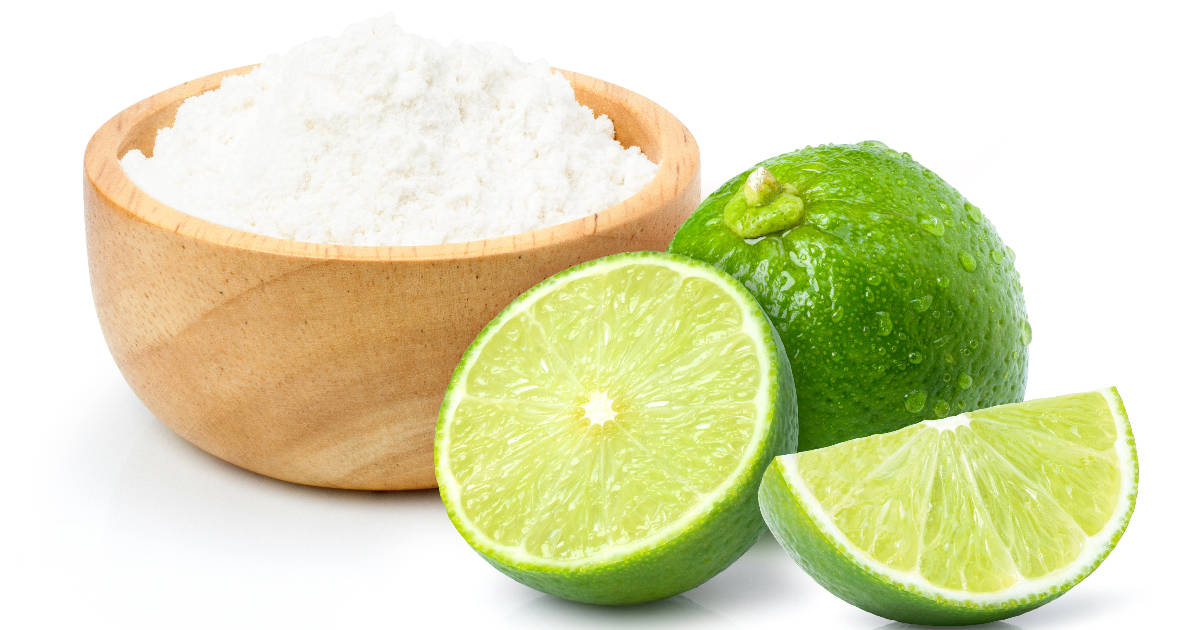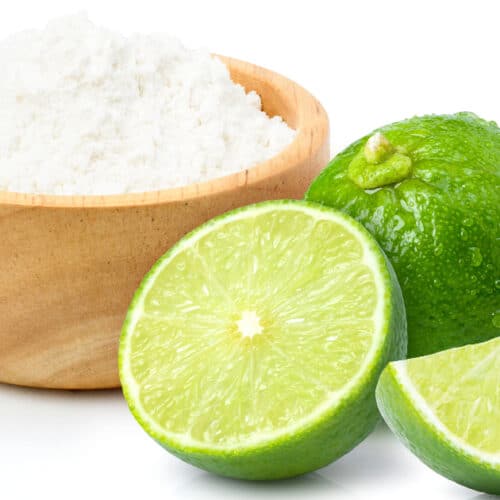Lime powder is a versatile ingredient that can add bright, fresh lime flavor to many dishes and beverages. It's made by dehydrating fresh lime peel or juice and then grinding it into a fine powder.

Lime powder has become more popular in recent years as people seek out natural flavors and less processed ingredients. The powder allows you to enjoy the zesty punch of lime year-round, without needing fresh limes on hand.
Selecting and Preparing Limes
The first step is picking fresh, juicy limes for your powder. Select limes that feel heavy for their size and have glossy, vibrantly green skins. Avoid any with brown spots or very pale color.
For this recipe, organic limes are best to limit any chemical residues. Plus organic produce is often fresher since it doesn't have wax or other preservatives applied.
Rinse your limes well before prepping them. If you plan to use the zest, scrub the skins first to remove dirt or residue.
You'll also need to decide whether to use just the zest (outer green layer) or the entire peel (zest and white pith). Using only zest gives you very pure, intense lime flavor. However the pith contains more pectin and nutrients. It does add some bitterness though. We recommend removing most of the bitter white pith if possible.
Key Takeaway: Select fresh, vibrant limes and scrub them clean before prepping. Remove most of the bitter white pith under zest if possible.
Dehydrating the Lime Peels and Zest
Once prepped, the next step is drying out the lime peels and/or zest. This removes moisture and concentrates the fruit's natural citrus oils and flavors.
You'll need a food dehydrator, oven, or even air drying to complete this step.
Each method explained:
Food Dehydrator
This is the preferred method if you have a dehydrator. Arrange peeled lime slices or zest on dehydrator trays in a single layer.
Dehydrate at 135°F for 6-12 hours, checking texture periodically, until completely dried out. Time varies based on thickness. Store dried peels in an airtight container until ready to grind.
Oven
If using an oven, place lime peels on a parchment lined baking sheet. Bake at the lowest temperature your oven allows, ideally around 150°F with the oven door propped open slightly.
This allows moisture to escape. Drying times are 12-24 hours. Check frequently to avoid over drying or burning.
Air Drying
You can also air dry peeled limes or zest at room temperature. This takes 1-2 weeks but requires no special equipment.
Simply spread out peels on a wire rack or mesh screen until brittle and completely dried. Store in an airtight container after.
Key Takeaway: Dehydrate lime peels using a food dehydrator, low temp oven, or air drying method. Dry until completely brittle and free of moisture.
Grinding Dehydrated Peels into Powder
Once your lime peels or zest are fully dried and brittle, they're ready to grind. You'll need a dedicated coffee/spice grinder or small food processor.
Break peels into smaller pieces first, then grind into a fine, fluffy powder. It's best to grind one citrus type at a time for purity of flavor.
As you grind, add 1⁄2 tsp sugar and pinch of salt per batch. This helps balance acidity, drawing out the fruit flavors. Citrus naturally has a high acid content which can taste very tart and acidic on its own.
Let powdered batches sit a minute after grinding to allow heat to dissipate. Then you can pass each batch through a fine mesh sieve to catch any pieces that didn't fully powderize.
If needed, grind stubborn chunks that don't pass through the sieve again for a more uniform texture.
Key Takeaway: Grind dried lime pieces in a dedicated coffee/spice grinder. Add a pinch of sugar and salt to mellow acidity. Pass powder through a sieve to remove any chunks.
Storing Your Lime Powder
It’s important to store freshly ground lime powder properly to retain maximum flavor and prevent caking.
Here are some tips for storage:
- Store powder in small airtight glass jars or containers. This protects against air exposure and humidity which can cause clumping.
- Refrigerate for longest life, up to 6 months.
- Can also store at room temperature in a cool, dark place for 2-3 months. Check periodically for clumping.
- Freezing is another option that locks in flavor indefinitely when stored in airtight containers or bags.
- No matter the storage method, try to minimize air exposure by really packing powder into your containers.
If stored properly, DIY lime powder can retain most of its vibrant flavor for months after grinding.
Let’s go over the best ways to use this versatile powder.
Using Lime Powder in Recipes
Homemade lime powder packs concentrated, tangy lime punch perfect for livening up recipes both sweet and savory.
Here are some suggested uses for your lime powder:
Drink Mix or Garnish
Lime powder mixes easily into water or sparkling drinks for refreshing lime flavor. You can also rim cocktail glasses with it.
Add just 1⁄2 to 1 tsp powder per 8 oz drink, adjusting to suit your tastes. The fine powder dissolves almost instantly.
Yogurt and Desserts
Stir a bit of lime powder into yogurt, ice cream, or creamy desserts. Citrus and dairy is a classic flavor pairing. Start with 1⁄4 tsp powder per serving.
Seasoning Blend
Spike the lime powder up further by blending it with complementary spices to make a citrusy seasoning blend. Think chili powder, cilantro, garlic, etc.
Baked Goods
Lime powder’s natural acidity can help recipes that use baking soda or baking powder rise better. Try folding it into scones, muffins, cookies, or cakes for flavor. It works with all types of batters.
Rubs and Marinades
Combine lime powder with oil, herbs and spices to make flavorful meat or fish rubs. Whisk it into salad dressings or marinades too. It's especially nice with chicken and seafood.
So in summary, lime powder is very versatile! It works great as a drink booster, spice blend ingredient or to add brightness to both sweet and savory recipes.

Homemade Lime Powder Recipe
Ingredients
- 2-3 medium limes, preferably organic
- 1/2 tsp sugar
- Pinch salt
Instructions
- Wash and dry limes. Using a vegetable peeler or small knife, remove peel from limes in strips, avoiding as much white pith as possible.
- Cut peels into small pieces. Arrange in single layer on dehydrator trays or baking sheets.
- Dehydrate at 135°F (in a dehydrator) or 150°F (in oven with door propped open) for 6-12 hours until completely dried and brittle.
- Break dried peels into smaller pieces. Working in batches, grind pieces into a fine powder using a dedicated coffee/spice grinder.
- Add 1⁄2 tsp sugar and pinch of salt to ground peels before grinding to help balance acidity.
- Pass ground powder through a fine mesh sieve to remove any remaining chunks.
- Transfer lime powder to an airtight glass jar or container. Store in refrigerator for up to 6 months or freezer indefinitely.
FAQs
Can you use other citrus fruit to make powder?
Yes! This same method works well for lemons, oranges, grapefruit, etc. Mix and match for your own custom blends too.
Does the whole lime need to be organic?
Organic is ideal, but if needed you can get away with just using organic lime zest and not the remaining fruit or pith. Peeling organically ensures no chemicals touch the part being dried and concentrated.
Is citric acid the same as lime powder?
While related, they are different products. Citric acid is an isolated acid additive, while lime powder delivers whole fruit flavor including essential citrus oils, vitamins, etc. Lime powder tastes fresher and more complex.
Can you use a blender instead of spice grinder?
A blender may work in a pinch, but does not grind as finely. For best texture and mixability, invest in an inexpensive coffee/spice grinder dedicated for grinding spices, herbs and powders.
Conclusion
We hope this article has shown how easy yet rewarding it can be to make your own lime powder at home. Within an hour or two you can have jars of tangy, vibrant powder ready to boost all sorts of recipes any time a burst of lime is needed.
Remember to select quality limes, remove bitter white pith from skins, dehydrate thoroughly, and store powder properly. Added to things like dressings, dips, drinks and more, it's amazing how a pinch of this powder makes recipes pop!

